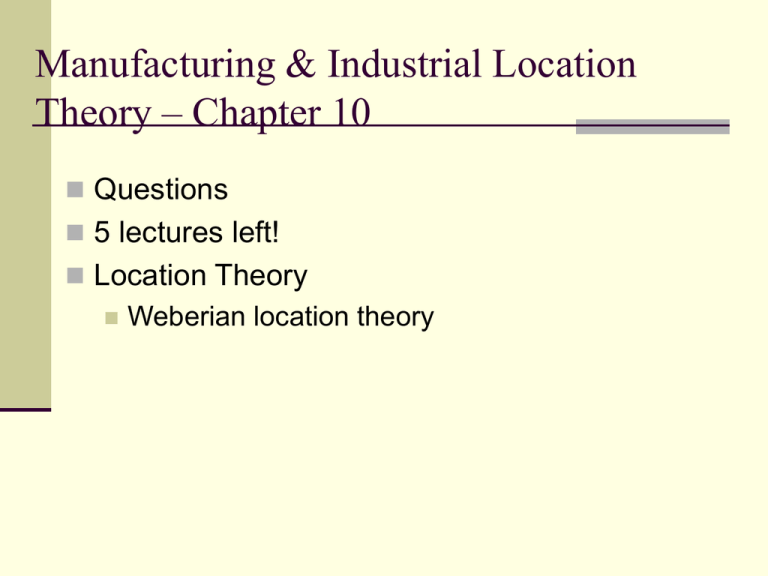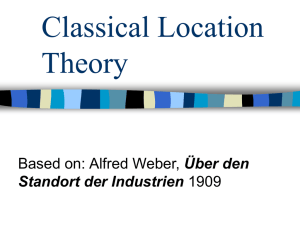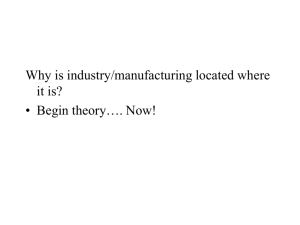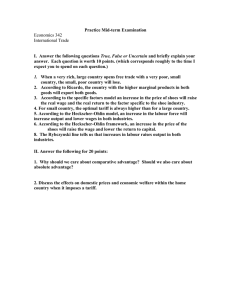Manufacturing & Industrial Location Theory – Chapter 10 Questions 5 lectures left!
advertisement

Manufacturing & Industrial Location Theory – Chapter 10 Questions 5 lectures left! Location Theory Weberian location theory Alfred Weber, 1909 One market, two localized Gross RMs Let’s assume two localized Gross RM sources, S1 & S2 Gross RMs, 50% weight loss for each S1, S2, or M = $4 Alfred Weber, 1909 One market, two localized Gross RMs Least cost location is likely to be some intermediate point Location is ‘pulled’ towards site of greatest weight loss Varignon frame Varignon Frame Source: P. Dicken and P.E. Lloyd Location in Space 3rd edition 1990 Harper&Row Alfred Weber, 1909 Labour costs: Isotims Labour costs as “distortion” to basic transport costs pattern Isotim Line of equal transport cost for any material, RM or FP “X” has cost of $3. Alfred Weber, 1909 Labour costs - Isodapanes Isodapane Line of total transport costs Determined by summing the value of all isotims at a point And joining all points of equal total transport costs Alfred Weber, 1909 Labour costs – Critical Isodapane Lower labour cost locations OR Cheaper locations due to agglomeration economies Total cost saving of $n per unit Do these locations lie within Critical Isodapane? i.e. $n isodapane If yes, move! (Assume no spatial inertia) Alfred Weber, 1909 Overlapping critical isodapanes Agglomeration economies What is wrong with Weberian industrial location theory? Single point markets Geographic variation in demand Over emphasis on transport Terminal costs ignored Labour is mobile yet localized Vast number of component inputs for most manufacturing Single plant independent firms is unrealistic Isard’s Substitution Principle P. 220 Skip it! Spatial Margins to Profitability Slopes could be very gradual Noneconomic factors may prompt nonoptimum location within margins Firms may not have data to determine the optimum Manufacturing: Regional Patterns and Issues Manufacturing in Canada Tariff Import substitution Protect infant industries Foster industrialization and create industrial jobs Linkages with other Canadian manufacturers 3rd Plank of the National Policy of 1869 Implications of the Tariff for Canadian Manufacturing Industrialization benefits for southern Ontario and Quebec, rapid urban –industrial growth Deindustrialization of Maritimes 1870s and 1880s Higher costs due to tariff and low Canadian productivity were a small price to pay for Ontario & Quebec The seeds of Western alienation Sir John A. & Conservatives! Implications of the Tariff for Canadian Manufacturing Foreign ownership Tariff factories Branch plant economy Technological dependency High costs, low productivity Not competitive on world markets No mandate to export Main links to U.S. not Canada! By 1980s, NTBs more significant Free Trade CUSFTA – 1 Jan 1989 NAFTA – 1 Jan 1994 Foreign location no longer a condition of entry Rationalization/specialization Canada maintains positive balance of trade Increases dependency: imports and exports Weak C$ has been key to success Dispute resolution mechanism





